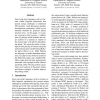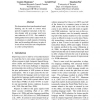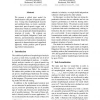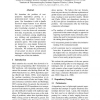134
Voted
ACL
2009
14 years 10 months ago
2009
Statistical models in machine translation exhibit spurious ambiguity. That is, the probability of an output string is split among many distinct derivations (e.g., trees or segment...
101
click to vote
ACL
2009
14 years 10 months ago
2009
The tree sequence based translation model allows the violation of syntactic boundaries in a rule to capture non-syntactic phrases, where a tree sequence is a contiguous sequence o...
76
Voted
ACL
2009
14 years 10 months ago
2009
Freer-word-order languages such as German exhibit linguistic phenomena that present unique challenges to traditional CFG parsing. Such phenomena produce discontinuous constituents...
76
Voted
ACL
2009
14 years 10 months ago
2009
This work investigates supervised word alignment methods that exploit inversion transduction grammar (ITG) constraints. We consider maximum margin and conditional likelihood objec...
100
Voted
ACL
2009
14 years 10 months ago
2009
We demonstrate that transformation-based learning can be used to correct noisy speech recognition transcripts in the lecture domain with an average word error rate reduction of 12...
85
Voted
ACL
2009
14 years 10 months ago
2009
We present a global joint model for lemmatization and part-of-speech prediction. Using only morphological lexicons and unlabeled data, we learn a partiallysupervised part-of-speec...
87
Voted
ACL
2009
14 years 10 months ago
2009
Short Messaging Service (SMS) is popularly used to provide information access to people on the move. This has resulted in the growth of SMS based Question Answering (QA) services....
108
Voted
ACL
2009
14 years 10 months ago
2009
While Active Learning (AL) has already been shown to markedly reduce the annotation efforts for many sequence labeling tasks compared to random selection, AL remains unconcerned a...
106
click to vote
ACL
2009
14 years 10 months ago
2009
We formulate the problem of nonprojective dependency parsing as a polynomial-sized integer linear program. Our formulation is able to handle non-local output features in an effici...
83
Voted
ACL
2009
14 years 10 months ago
2009
We present a novel transition system for dependency parsing, which constructs arcs only between adjacent words but can parse arbitrary non-projective trees by swapping the order o...




